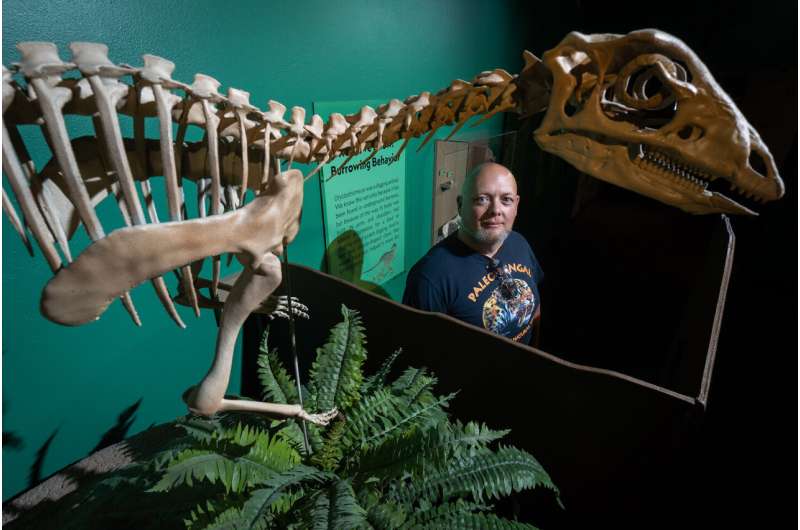This article has been reviewed according to Science X's editorial process and policies. Editors have highlighted the following attributes while ensuring the content's credibility:
fact-checked
peer-reviewed publication
trusted source
proofread
New analysis sheds light on Idaho's state dinosaur

New findings from an Idaho State University paleontologist are answering some questions about Idaho's State Dinosaur and raising a few more.
A new paper published in the Journal of Vertebrate Paleontology details the findings of L.J. Krumenacker, adjunct professor of geosciences at Idaho State University, affiliate curator at the Idaho Museum of Natural History, and professor of geology and biology at the College of Eastern Idaho, and his co-author's work on analyzing hundreds of bones from over a dozen individual specimens of Oryctodromeus.
This burrowing dinosaur was about the size of a large dog and roamed ancient Idaho during the Cretaceous Period, and part of what they found was that about two-thirds of the animal's length was just its tail.
"Some of the fun of science is when you get new answers, it usually gives you new questions," said Krumenacker. "Why did Oryctodromeus have such a long tail? It's not something you'd expect to see in a burrowing dinosaur."
The group's other findings include ossified tendons from among the fossils. Rather than staying pliable like other tendons, ossified tendons have hardened into bone. The tendons are found along the specimens' tails, necks, and backs.
"These tendons would have provided rigidity and support to the animal's spinal column," Krumenacker explained. "With the long tail and these tendons taken into account, how did Oryctodromeus turn around in a confined burrow?
"One hypothesis is that the burrows had separate and/or multiple entrances and exits. Another is they may have lived in burrow colonies like today's groundhogs. Plus, some animals have lots of tendons, and others have none. Does this reflect a difference between the males and females or in the animal's age?"
The additions of the newly found bones from the mountains east of Idaho Falls, Idaho, and south of Lima, Montana now make Oryctodromeus one of the most complete specimens from the group of dinos known as the orodromines. These burrowing dinosaurs lived primarily in what is now the United States and Canada but have also been found in South Korea.
"Orodromines are unique for being the first recognized burrowing dinosaurs," Krumenacker said. "They've helped researchers recognize that this may have been a more common lifestyle in small dinosaurs than previously thought."
At the Idaho Museum of Natural History (IMNH), the Oryctodromeus specimens are being digitally scanned by museum staff as part of a project to digitize all of the dinosaur-age fossils at the IMNH.
The 3D scans will be available via Morphosource, "a publicly accessible 3D data repository where subject experts, educators, and the general public can find, view, interact with, and download 3D and 2D media representing physical objects important to the world's natural history, cultural heritage, and scientific collections."
"The fossils we've scanned include dinosaur eggs, teeth, and bones," said Robert Gay, education coordinator at the IMNH. "Over 450 partial or complete bones have been scanned as part of this project, 30% of which belong to our state dinosaur Oryctodromeus."
The team will also complete a new and updated mounted Oryctodromeus skeleton based on the scan data and the latest paper from Krumenacker and his co-authors. The IMNH has also produced education kits for the USFS that will be available in select locations throughout Idaho to help educate the public about Idaho's State Dinosaur.
"It is important to conserve and educate about our state dinosaur because it is part of our shared natural heritage here in Idaho," Gay said. "Idaho is the first place in the world that digging dinosaurs have been recognized from, and learning more about them—and their environment—can help unlock a new understanding of our past. The IMNH's mission is to educate the public about Idaho's natural history, and dinosaurs are a gateway to engaging students in the STEM fields."
"I think appreciating any aspect of the natural world leads to people taking better care of it," said Krumenacker. "Whether it's dinosaurs, modern animals and plants, or anything outdoors, an appreciation for things like this leads to better stewardship of a finite and unique planet."
More information: L. J. Krumenacker et al, Osteology and phylogenetic relationships of the mid-Cretaceous neornithischian dinosaur Oryctodromeus cubicularis Varricchio, 2007. Journal of Vertebrate Paleontology (2024). DOI: 10.1080/02724634.2024.2330581
Journal information: Journal of Vertebrate Paleontology
Provided by Idaho State University




















